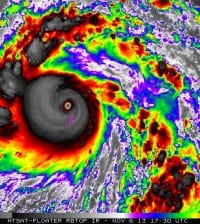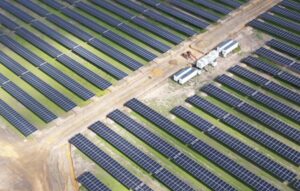Super Typhoon Haiyan has passed over the Philippines and is now weakening over China, but the impact it left on the the island nation in Southeast Asia is just setting in. At least 10,000 people are feared to have been killed according to the provincial government of Leyte, the worst hit of the nation’s provinces, with at least 1,774 bodies already officially accounted for.
According to the BBC, more than nine million people have been affected in the Philippines, with more than 600,000 people left homeless.
The United Nations has authorized $25 million in emergency funds to provide food, temporary shelters, health services, drinking water, and sanitation and has issued an appeal for a further $300 million.
“Many thousands of people are reported to have died and almost 10 million people have been affected … Let us all show our solidarity with the people of the Philippines at this time of need,” UN Secretary General Ban Ki-moon said after describing images of the storm as “heartbreaking”.
Forty percent of the population in the Philippines lives on $2 or less per day and makeshift infrastructure makes many residences more vulnerable to extreme weather events.
Support has flowed in from more than 20 countries, Philippine authorities said.
The UN children’s fund UNICEF said a cargo plane carrying 60 tonnes of aid including shelters and medicine would arrive in the Philippines Tuesday, to be followed by deliveries of water purification and sanitation equipment.
The US aircraft carrier USS George Washington, which has 5,000 sailors and more than 80 aircraft aboard, headed from Hong Kong towards the Philippines on Tuesday. Five other US warships are also being deployed. The U.S. has also offered $20 million in humanitarian aid. Secretary of State John Kerry told Philippine Foreign Minister Albert del Rosario that the U.S. government will provide “all necessary assistance.”
The Typhoon’s Role In Climate Talks
Christiana Figueres, executive director of the UN framework convention on climate change (UNFCCC) said Monday that Super Typhoon Haiyan served as a backdrop of “sobering reality” for the 19th United Nations Framework Convention on Climate Change, or COP19, happening this month in a football stadium in Warsaw, Poland.
“We must stay focused, exert maximum effort for the full time and produce a positive result, because what happens in this stadium is not a game,” Figueres told delegates. “There are not two sides, but the whole of humanity. There are no winners and losers, we all either win or lose in the future we make for ourselves.”
Philippine Climate Change Commissioner and lead climate negotiator Naderev “Yeb” Saño also delivered some potent remarks during the opening session of COP19, saying, “with an apparent cruel twist of fate, my country is being tested by this hellstorm called Super Typhoon Haiyan”:
“It was so strong that if there was a Category 6, it would have fallen squarely in that box … To anyone outside who continues to deny the reality that is climate change, I dare them, I dare them to get off their ivory towers and away from the comfort of their armchairs. I dare them to go to the islands of the Pacific, the Caribbean, the Indian ocean and see the impacts of rising sea levels; to the mountainous regions of the Himalayas and the Andes to see communities confronting glacial floods, to the Arctic where communities grapple with the fast dwindling sea ice caps, to the large deltas of the Mekong, the Ganges, the Amazon, the Nile where lives and livelihoods are drowned, to the hills of Central America that confronts similar monstrous hurricanes, to the vast savannas of Africa where climate change has likewise become a matter of life and death as food and water become scarce.”
Saño deviated from his prepared remarks to pledge that he would refrain from eating at the convention until “a meaningful outcome is in sight.”
He called for global solidarity and enhanced ambition in confronting climate change, specifically calling on the COP to deliver meaningful progress on a pledge by rich countries to deliver $100 billion from 2020 to help developing countries cope with the impacts of climate change.
Saño went on to say that the typhoon made landfall in his family’s hometown, and that as he agonizes while waiting for the fate of friends and family the news that his brother survived the onslaught gives him renewed strength.
“Climate change will mean increased potential for more intense tropical storms and this will have profound implications on many communities, especially who struggle against the twin challenges of the development crisis and the climate change crisis,” Saño said.
The Typhoon’s Role In Climate Change
According to CNN, Super Typhoon Haiyan may have hit the Philippines with the strongest sustained cyclone winds on record at 195 mph. Scientists are still analyzing the data. Gusts reported at first landfall that rose to 235 mph would also be a record if confirmed.
Senior Presidential aide Rene Alemendras told the AP that preparation efforts anticipated the wind but not the water. Leyte and its capital city of Tacloban — home to 200,000 — was inundated by storm surges as high as 20 feet.
According to Climate Central, there is increasing evidence that climate change is making the impacts of storm surges worse by raising the underlying sea levels. However, studies still show a high amount of uncertainty about how global warming is affecting the frequency and intensity of West Pacific typhoons.
Professor Will Steffen, a researcher at Australian National University, told the Sydney Morning Herald that scientists understand how a hotter, moister climate is already affecting storms such as Haiyan.
“Once [cyclones] do form, they get most of their energy from the surface waters of the ocean,” Professor Steffen said. “We know sea-surface temperatures are warming pretty much around the planet, so that’s a pretty direct influence of climate change on the nature of the storm.”
Data compiled from the US National Oceanic and Atmospheric Administration shows sea temperatures were about 0.5 to 1 degree above normal in the waters to the east of the Philippines as Haiyan began forming.
Kerry A. Emanuel, an atmospheric scientist at M.I.T., told the New York Times that that as the planet warms the difference between sea and air temperatures increases and that this differences fuels the increased intensity of storms like Haiyan.
“As you warm the climate, you basically raise the speed limit on hurricanes,” he said.
This article was originally published on Climate Progress. Reproduced with permission








